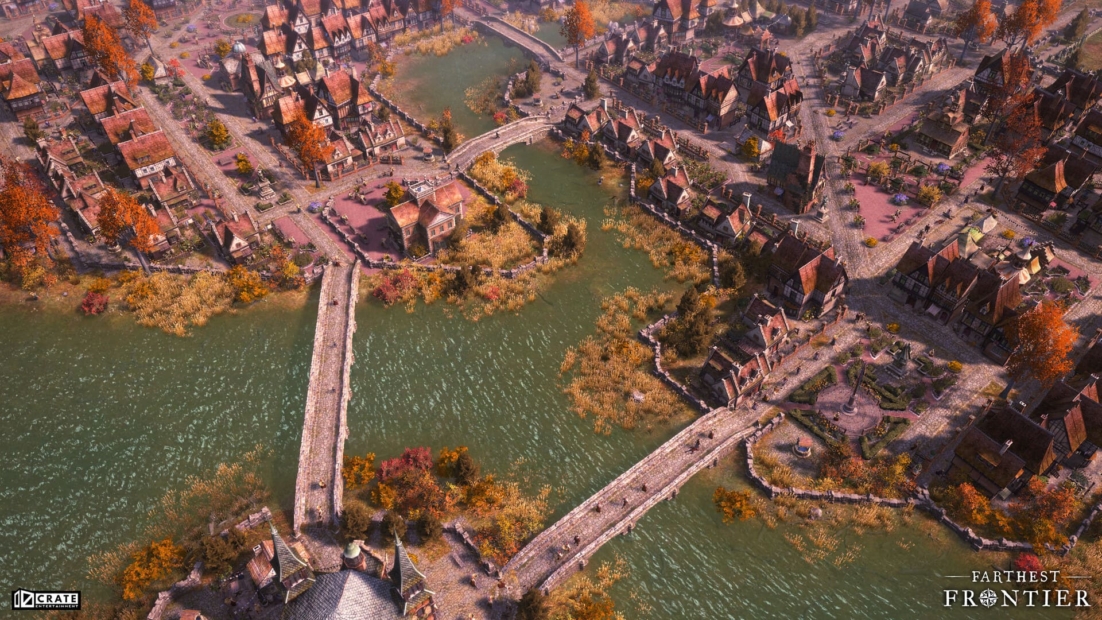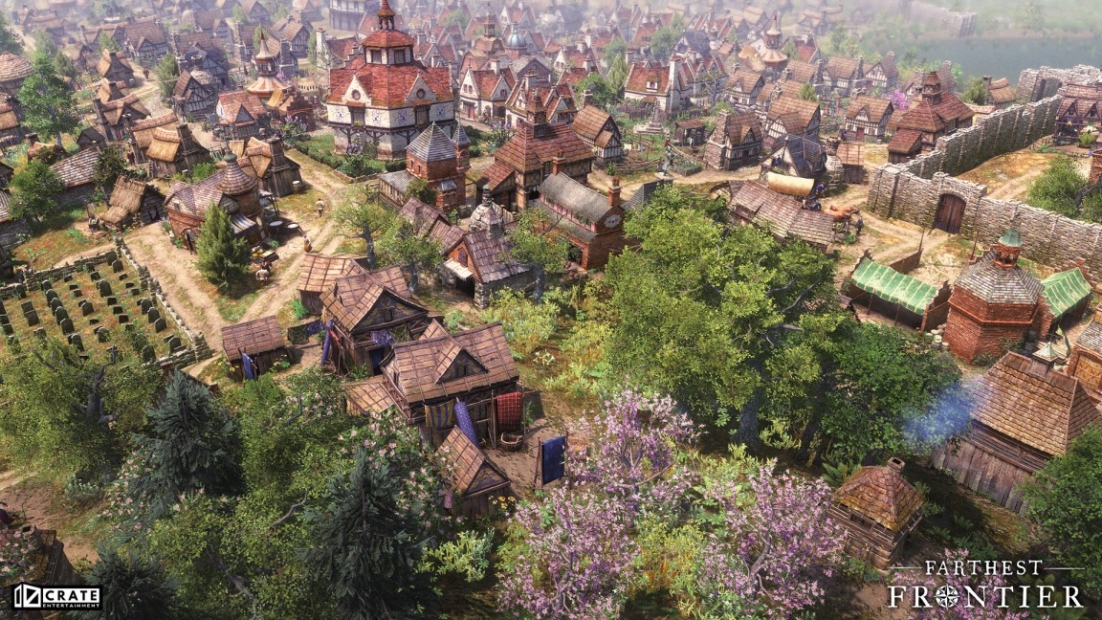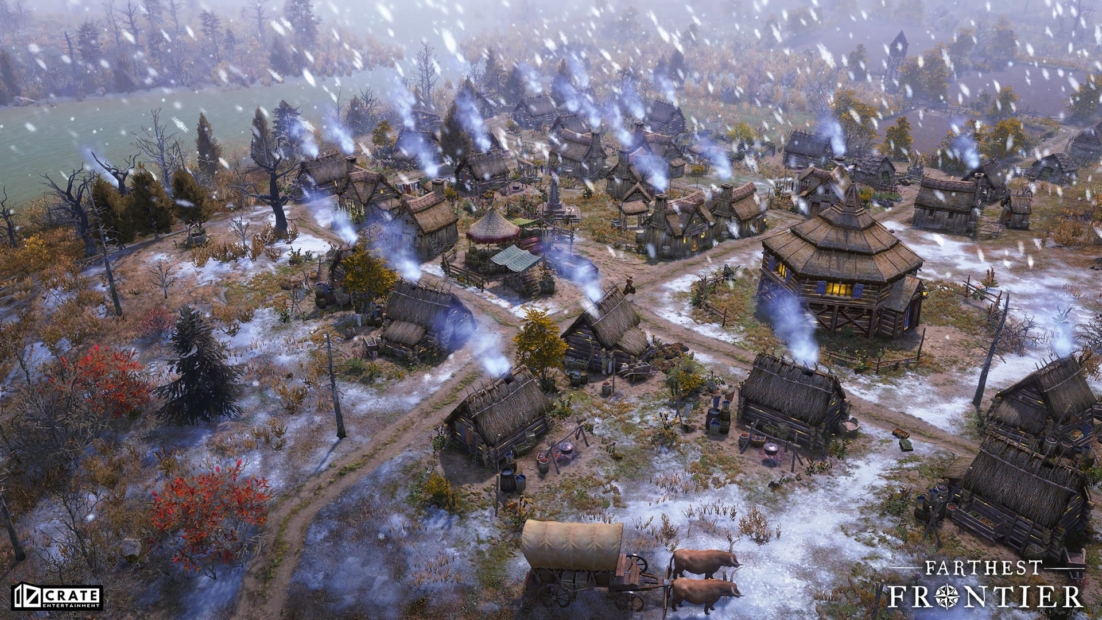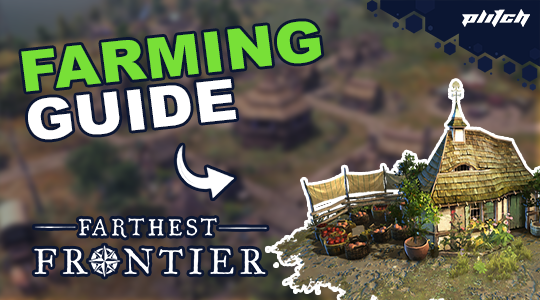The latest game by the Grim Dawn developers is a city-building simulation, which in its best moments is even better than the Anno series. In our Farthest Frontier Tips and Tricks for Beginners, we’ll show you how to build a thriving and prosperous medieval city and protect your people from all dangers in this complex building game.
Table of Contents
Adjust the Settings
After clicking on “New Settlement,” you set the basic conditions for your adventure. You can choose between the map types “Arid Highlands,” “Idyllic Valley,” “Lowland Lakes,” “Alpine Valleys,” and “Plains.” You can also generate a random map. For the size, you can select large, medium, or small areas.
To start, we recommend a randomly generated medium-sized map, as this ensures different biome types are well mixed. Each biome offers unique resource deposits; for instance, you’ll find more fish in the lowland lakes, while the arid highlands are abundant in ore and wood.

Choosing the pacifist mode decides if battles happen in your gameplay and whether your citizens or city can be invaded. You also get to set the difficulty level. As a pioneer, you’ll start with plenty of resources, and your people will experience health issues less often. Additionally, there are more animals to hunt.
On the medium difficulty level – trailblazer – you must fight your way through with significantly fewer resources, and wild animals are only available in certain hotspots. Also, your people can get sick more often.
The highest level, Vanquisher, is only for experts. You start with almost nothing, and all the challenges the game offers are set in your way during village construction. Therefore, we recommend you begin as a pioneer.
The Best Place For Your City Center
The location of the city center is vital for the successful building of the village in Farthest Frontier. There are several factors to consider. On one hand, it should be as flat as possible in the surrounding area so you don’t have to level anything; on the other hand, you should pick a place where there isn’t too much forest. This way, you don’t have to cut down too many trees, and you can start constructing houses right away.

Also, ensure there’s a body of water and food sources like berries or wild animals nearby. Access to resources such as ores, clay, and sand will also become important as the game progresses.
Farthest Frontier Tips: How to Collect Resources
You need resources for the city center and all other buildings in Farthest Frontier. To have your workers collect them, click on the “Harvest resources” button or use the shortcut H. Through the harvest menu, you can choose which resources to harvest. Then, select an area where they’re located, and your settlers will start working.
However, ensure that the area you choose is near the city center so that the distances are minimized and you don’t waste any time.
How to Get Food Supplies
You need food supplies in Farthest Frontier so your people don’t go hungry. You can obtain them in various ways. With a hunter’s cabin, you can hunt wild animals, and with a storage unit for food, you can automatically gather berries, herbs, and nuts.
You can also place fishing shacks near a body of water. The relevant resources must also be nearby. For example, a hunter’s cabin is only useful where there are deer or wild boars.
Each cabin or shack has a working radius where the workers are active. To keep efficiency high, you should adjust and move it from time to time. This becomes necessary, for example, when the fishing grounds of the fishing shack are exhausted or when all the animals within the radius of the hunter’s cabin have been killed.
Build Houses and Roads
To turn your village into a city in Farthest Frontier, your people need a place to live. To do this, go to the building menu and then to the “Housing” tab. There you’ll find houses and cabins that you can freely place in the world. Before you do that, however, you should think about a layout that is as practical as possible. You can move buildings later, but the better you plan ahead, the easier it will be when your city grows.

Your residential buildings can be connected to the city center and other structures with roads and pathways. This isn’t mandatory, but it offers the benefit that your workers will walk faster on a paved surface than through woods and meadows.
To ensure the hygiene and water supply for your citizens, it also makes sense to place wells near residential buildings. As in the Anno series, the shacks can later be upgraded to better houses.
💡 Tip: Also check out our Farthest Frontier farming guide.
Prepare For Winter

The changing seasons play a big role in the game. So, as part of our Farthest Frontier tips and tricks, it’s important to prepare well for winter to prevent your people from freezing or starving. Make sure to gather enough firewood in advance. You can do this using a Firewood Splitter, where wood is processed.
How to Increase the Appeal of Your Settlement
For your cabins to become actual houses in Farthest Frontier, the building site must be appealing to your people. If they are happy with their surroundings, they will use your resources to upgrade their homes. Nearby production buildings, for example, reduce the attractiveness. Therefore, make sure to build housing as far away as possible.
Providing access to various foods, luxury resources, and fresh water, along with building service structures like an inn, a school, or a theater, can boost the appeal and overall well-being of your citizens.
How to Move Buildings
Not everything can be planned in advance. Occasionally, it’s necessary to move buildings in Farthest Frontier. Luckily, you don’t have to demolish and rebuild it; you can simply move it to save resources. To do this, click on the corresponding building and then select “Move building” in the upper right corner.
How to Repair Buildings
Not only do your citizens in Farthest Frontier age with time, but your buildings also decay over the years. To prevent them from collapsing, they must be repaired regularly. You can see their condition on the yellow bar above them.
However, since your workers can’t be actively assigned to a building, you need to pause all current construction projects periodically so they can focus on repairing existing ones. And, of course, you must have the necessary materials available.
Use Your Trading Posts
As already mentioned, the season is essential in Farthest Frontier. During spring and summer, traders visit your settlement and stay for a few days. To sell goods, you need to transport them to the trading post first. You can do this using the button with the same name, which allows you to select the type and amount of goods to move.
But traders are picky. They don’t buy and sell everything. You can find supply and demand info in your inventory display. There are three types of arrows there. A left arrow means the merchant only sells this good. The right arrow means he only wants to buy this good. If both arrows are next to the goods, you can buy and sell from them.
When it comes to transportation, the process is very specific. Not only do you have to send every raw material and every item you want to trade to the post first, but also the goods you have purchased must be collected using the “transport” button. Additionally, you need to bring the required currency to the trading post first so you can use it. To do this, click on the “Gold transfer” button.
Get Started With PLITCH!
With our Farthest Frontier tips and tricks, you should find it easy to get started. However, the Middle Ages can be unforgiving. Resource shortages and sudden diseases can lessen the fun and threaten your survival in the wilderness.
With PLITCH’s Farthest Frontier cheats, you can remove diseases and farm items for your buildings. You can also change your citizens’ movement speed and control the time. This helps you avoid frustration and make quick progress, even if you’re short on time or the game’s difficulty level is challenging.
Check out this blog and our YouTube channel to learn more about PLITCH and our codes!
Happy Gaming!

